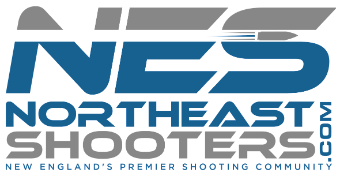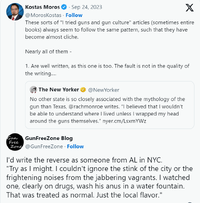rep308
NES Member
The WSJ is the only newspaper I trust and pay money to read so I'm a little disappointed here. It is still an interesting article, the under 40 crowd maybe surprised at the amount of hate that AR owners (including me) got at the range in the early 90's. They outline the AR's history and focus on Bushmaster and the money that private equity firms made on their investment. The writer is shocked that sales of the AR surged after mass shootings, missing the point in my opinion, that if you try to ban something, everyone suddenly wants one.
Yes there is a paywall but I'll snip a bit and clever folks can figure a way around

 www.wsj.com
www.wsj.com
In December 2005, five groups of Wall Street investors flew in private jets to Portland, Maine, where they took waiting limousines to a warren of metal buildings that resembled a midsize lumberyard. They had come to Bushmaster Firearms in pursuit of a highly profitable product whose market was growing faster than any other in America’s stagnant gun industry. The product was the AR-15, and red-hot Bushmaster, the nation’s leading manufacturer of the rifle, had decided to auction itself to the highest bidder.
Bushmaster’s owner Dick Dyke had once feared that he could never sell the company because so many people had a negative view of the gun. A few years earlier, Dyke had been forced to resign his post as President George W. Bush’s chief Maine fundraiser after the media found out he made AR-15s for a living. After that, his company was again pilloried when two snipers who terrorized the Washington, D.C. area used a Bushmaster in their attacks.
But by 2005, Dyke’s concerns had evaporated. Sales of the AR-15 were growing faster than any other rifle or shotgun. When Dyke let it be known that he might be interested in selling, potential private-equity buyers rushed up to Maine to see his operations and make a bid for the AR-15 maker. “All of the sudden, they became an amazing thing,” recalled John DeSantis, Bushmaster’s chief executive......snip
......Sales of a civilian version of the AR-15, first marketed to hunters in the early 1960s, were weak for decades. Its martial look and function, its small-caliber bullets and the plastic and aluminum parts were a turn-off for many hunters used to rifles made of polished wood and gleaming steel. Serious problems with the roll-out of the M16 in Vietnam led many veterans of that conflict to dislike the gun. Soldiers died on the battlefield with M16s in their hands because of jamming problems caused by changes made by the military to the gun’s ammunition and other issues. Beyond Doomsday preppers and collectors, most gun-owners weren’t interested.
In 1977, Stoner’s patent expired, opening up competition for Colt, the storied gunmaker that manufactured both military and civilian versions of the rifle. By the 1980s, a handful of smaller gunmakers were making and selling civilian versions of the AR-15.
These companies received strongly negative reactions to the guns when they displayed them at NRA conventions in the 1980s and 1990s. “We’d have NRA members walk by and give us the finger,” said Randy Luth, owner of DPMS Panther Arms, one of the AR-15 makers.....snip
....On Dec. 14, 2012, a frail 20-year-old beset with mental problems used the Bushmaster purchased by his mother to attack Sandy Hook Elementary School near his home in western Connecticut. He shot and killed 20 first-graders and six educators before killing himself.
The immediate aftermath was akin to the U.S. reaction to 9/11—bafflement, sadness, horror, anger. The funerals for the Sandy Hook Elementary School victims began on a gray day, Dec. 17, when Noah Pozner and Jack Pinto, both six years old, were laid to rest. Six-year-old Ben Wheeler’s funeral was held on Dec. 20 at Trinity Episcopal Church. It was filled to capacity. His father read “The Road Not Taken” by Robert Frost.
On that same day, Freedom Group’s board of directors held an emergency meeting by telephone. Kollitides, who had risen to become Freedom Group’s chief executive, thanked the board members for meeting on short notice. He informed them that Cerberus, under pressure from major investors, had decided to consider selling the gun company after the shooting.
Kollitides noted that gun sales continued to be strong after the tragedy and then turned to other matters, including the possible acquisition of a gun-barrel manufacturer. The board still had business to attend to while they awaited a possible sale. Some in the meeting noted that the deal for the barrel maker would increase margins even further on the company’s AR-15s. The board voted to authorize the acquisition. Cerberus would ultimately decide against selling its gun firm as sales of AR-15s soared after Sandy Hook.
“It was an awful, horrific, huge tragedy, but its impact on the long-term capital decisions of the business were not—were not a factor,” Kollitides later said in a deposition. “We were in the business of legally making guns to legally sell to legal gun owners. So there is no other thing to do than wake up and make guns on Monday morning.”.....end
Yes there is a paywall but I'll snip a bit and clever folks can figure a way around
The Selling of America’s Most Controversial Gun
Private equity turned the AR-15 into a big profit-maker and a charged symbol in the debate over gun rights and mass shootings.

Essay | The Selling of America’s Most Controversial Gun
Private equity turned the AR-15 into a big profit-maker and a charged symbol in the debate over gun rights and mass shootings.
In December 2005, five groups of Wall Street investors flew in private jets to Portland, Maine, where they took waiting limousines to a warren of metal buildings that resembled a midsize lumberyard. They had come to Bushmaster Firearms in pursuit of a highly profitable product whose market was growing faster than any other in America’s stagnant gun industry. The product was the AR-15, and red-hot Bushmaster, the nation’s leading manufacturer of the rifle, had decided to auction itself to the highest bidder.
Bushmaster’s owner Dick Dyke had once feared that he could never sell the company because so many people had a negative view of the gun. A few years earlier, Dyke had been forced to resign his post as President George W. Bush’s chief Maine fundraiser after the media found out he made AR-15s for a living. After that, his company was again pilloried when two snipers who terrorized the Washington, D.C. area used a Bushmaster in their attacks.
But by 2005, Dyke’s concerns had evaporated. Sales of the AR-15 were growing faster than any other rifle or shotgun. When Dyke let it be known that he might be interested in selling, potential private-equity buyers rushed up to Maine to see his operations and make a bid for the AR-15 maker. “All of the sudden, they became an amazing thing,” recalled John DeSantis, Bushmaster’s chief executive......snip
......Sales of a civilian version of the AR-15, first marketed to hunters in the early 1960s, were weak for decades. Its martial look and function, its small-caliber bullets and the plastic and aluminum parts were a turn-off for many hunters used to rifles made of polished wood and gleaming steel. Serious problems with the roll-out of the M16 in Vietnam led many veterans of that conflict to dislike the gun. Soldiers died on the battlefield with M16s in their hands because of jamming problems caused by changes made by the military to the gun’s ammunition and other issues. Beyond Doomsday preppers and collectors, most gun-owners weren’t interested.
In 1977, Stoner’s patent expired, opening up competition for Colt, the storied gunmaker that manufactured both military and civilian versions of the rifle. By the 1980s, a handful of smaller gunmakers were making and selling civilian versions of the AR-15.
These companies received strongly negative reactions to the guns when they displayed them at NRA conventions in the 1980s and 1990s. “We’d have NRA members walk by and give us the finger,” said Randy Luth, owner of DPMS Panther Arms, one of the AR-15 makers.....snip
....On Dec. 14, 2012, a frail 20-year-old beset with mental problems used the Bushmaster purchased by his mother to attack Sandy Hook Elementary School near his home in western Connecticut. He shot and killed 20 first-graders and six educators before killing himself.
The immediate aftermath was akin to the U.S. reaction to 9/11—bafflement, sadness, horror, anger. The funerals for the Sandy Hook Elementary School victims began on a gray day, Dec. 17, when Noah Pozner and Jack Pinto, both six years old, were laid to rest. Six-year-old Ben Wheeler’s funeral was held on Dec. 20 at Trinity Episcopal Church. It was filled to capacity. His father read “The Road Not Taken” by Robert Frost.
On that same day, Freedom Group’s board of directors held an emergency meeting by telephone. Kollitides, who had risen to become Freedom Group’s chief executive, thanked the board members for meeting on short notice. He informed them that Cerberus, under pressure from major investors, had decided to consider selling the gun company after the shooting.
Kollitides noted that gun sales continued to be strong after the tragedy and then turned to other matters, including the possible acquisition of a gun-barrel manufacturer. The board still had business to attend to while they awaited a possible sale. Some in the meeting noted that the deal for the barrel maker would increase margins even further on the company’s AR-15s. The board voted to authorize the acquisition. Cerberus would ultimately decide against selling its gun firm as sales of AR-15s soared after Sandy Hook.
“It was an awful, horrific, huge tragedy, but its impact on the long-term capital decisions of the business were not—were not a factor,” Kollitides later said in a deposition. “We were in the business of legally making guns to legally sell to legal gun owners. So there is no other thing to do than wake up and make guns on Monday morning.”.....end
Last edited:




